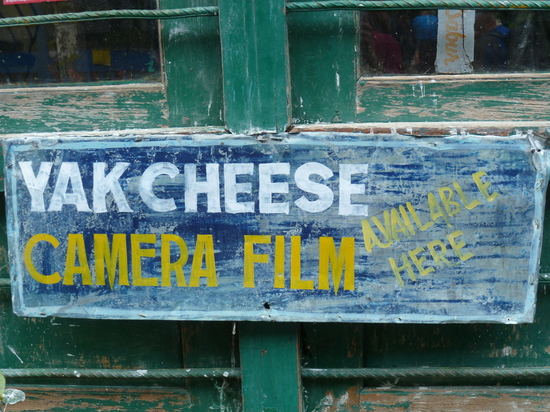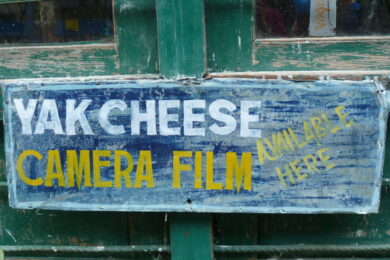“It was fantastic that only a few hours after seeing these giant flowers and inviting turf we were to be walking on glaciers of such a scale that our cheerful assurance would suddenly change to awestruck respect.” – Maurice Herzog, while scouting routes around the base of the Annapurna range, 1950
Part 2: Easy as 1-2-3
=========
As things stand, the highest point we’ve reached is Poon Hill, standing proudly at 3,210 metres. To get to Annapurna Base Camp at 4,130 metres, we must first descend to ascend, passing through villages and jettisoning as much gear as we can to make life easier for our porters. Regarding whom a quick note: the porters for our group (there are eight for sixteen trekkers) each carry two 12kg bags. So by the time they’ve loaded up on their own stuff too, they could be carrying about 30kg each – and travelling much faster than us with our piddly day-packs. It’s even more shocking to learn that this is, by Nepalese standards, a plum job – the number of porters we see hauling shops-worth of produce, crates of beer and coke and, at one point, a set of four metal tables, is staggering.
So we carry on, downwards to eventually go upwards. The next four days will see us loop round via Annapurna Base Camp (henceforth to be referred to as ABC), starting and ending at the holiday-flavoured town of Chhomrong, hopefully with clear enough weather to enjoy the panorama at the top. We descend from our last stop-over at Ghorepani, with views of Machapuchare, the fish-tail mountain. Soon, that view will disappear – we’ll be too close to it to see the peak properly.
When we reach Chhomrong in the late afternoon, the whole group is struck by how relaxed it is. It’s the last major settlement before ABC and the last one with hot showers, two-person rooms and well-stocked shops. Our lodge is modest but comfortable. The menu in the dining hall features, for the first time so far, yak steak (which, if you’re wondering, is presented on a sizzling hotplate and is a spongier, foamier alternative to beef). The group chats sociably about their home lives, probably because it’s the closest thing we’ve experienced to a normal holiday so far.
However, next morning, we must leave the banks of marigolds that line the streets and the herded goats that tramp merrily through them. After yesterday’s descent, we’re now undulating in height through jungle, moist with humidity and strung together by spectacular waterfalls. I think of the porters in this heat, even though we’ve been instructed to empty our bags of non-essentials to make life a little easier for them. At each stop, we put as much water as we can carry in our camel baks – later today we’ll pass the point where mineral water is no longer available. From now on, it’s strictly boiled.
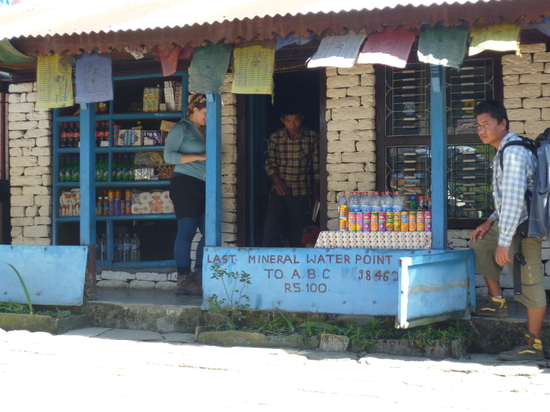
It’s Remembrance Day. One of our group is an ex-serviceman, and at 11AM encourages us to use our minute’s silence to think of all who’ve fallen in combat, but especially the Ghurkhas, native to these mountains. We stand in a line on a jungle hillside, in silence. Loneliness doesn’t mean just geographical dislocation – for one of the only times in my life, I feel positively British. A foreigner in another land, thinking about home. But there’s no time to dawdle, we’ve got to reach Dovan by nightfall and the weather is not going to be as forgiving as it has been.
At our lunch stop we see a French trekker being propped up by two Nepalese guides. He doesn’t look well, but he does look sort-of happy. A quick inquiry from our head guide tells us that this man has foolishly sampled some of the local wild honey, freely available in great hives made from hollowed-out tree logs. So, our guide tells us, a few mouthfuls of the untreated honey can result in hysteria and hallucinations, and those who have eaten it are noticeable by their inability to support themselves and their vacant looks. Which gets me thinking; there could be an incredible, nature-minded stoner metal scene up here. We’re walking around the base of a Holy Mountain and there are hallucinogens freely available to anyone with a step-ladder. Get some porters to lug up some battered Peavey amps and some second-hand Flying-Vs and you’ve got yourself some natural successors to Wolves In The Throne Room.
The weather soon makes itself known as the moistness of the jungle is matched by cloud, drifting in all around and above us. It’s one thing to be in a cloud when you’re on a plane, but to walk through one as the evening crowds you is something else entirely – you become wet, hot and disoriented rather than alive with the joys of nature. By the time we reach Dovan (where tonight we are resident at the exceptionally-named Hotel Tip-Top), the proprietors are attaching tarpaulin to everything in anticipation of heavy rain. We sit outside and drink fruit tea for as long as we can stand before heading indoors. Tomorrow we are due to climb 1,500 metres in total and, with this weather, we’re going to need some extra help to make it to ABC.
Fortunately we pass a small Buddhist shrine the next morning, decked out with scarves and with marigolds scattered all about it. Our guides, all four of them Buddhists, ring the bells inside the shrine and put marigolds in our hair. They have prayed for good weather as we make our ascent. Even with this endorsement and, we’re assured, their best Gods on the case, the cloud surrounds us and obscures any mountains we might be slinking past. For now, we can just about see the trees and occasional waterfalls around the group, but not much else. A quick stop in the same sandy cave that the porters from the ill-fated Machapuchare summit attempt used (the attempt that ended with the washing away of two mountainside towns and is the reason for the mountain’s sacred status) tells us that we’re close to Machapuchare Base Camp, the last stop before Annapurna Base Camp.
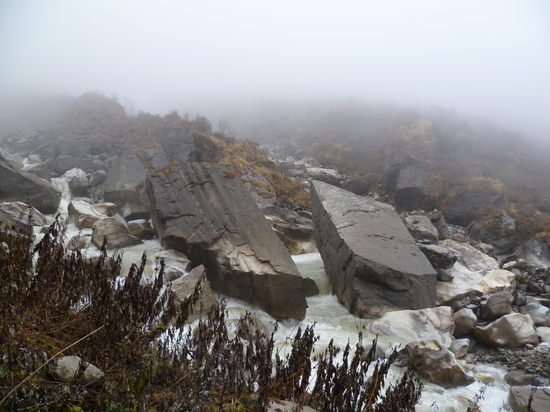
The weather shows no signs of improvement, so we resolve to leave extra early the next morning, to ensure we get as much time at ABC as possible. When we start our ascent the next morning the terrain changes quickly from lush mountainside to bleak, boggy and snowy plain. Green turns to brown, lush turns to harsh. One immense snow drift we pass has evidently slipped from several thousand metres above where we are in an avalanche – not the slightest bit uncommon in this weather. We can see, in the smallest way, exactly what Herzog was talking about.
Strangely, the weather begins to improve as we approach ABC, but almost as soon as we can see it in the distance, the cloud descends once again. Our guide mentions, quite casually, that 20 days before we set off a group of Korean climbers had made their assault on the summit of Annapurna. Nothing had been heard from them since then. They were attempting to climb all the world’s 8,000+ metre peaks, and Annapurna was the last one on the list.
Just after lunchtime, we see the poles that used to prop up the ABC sign that welcomed tourists. To one side is a pitiful replacement that tells you that you’ve reached ABC, and that there’s some sort of refuse collection going on. This sign, though, tells us that we’ve reached our highest point at 4,130 metres. It’s an odd elation, empty because we can’t completely see what we’ve reached.
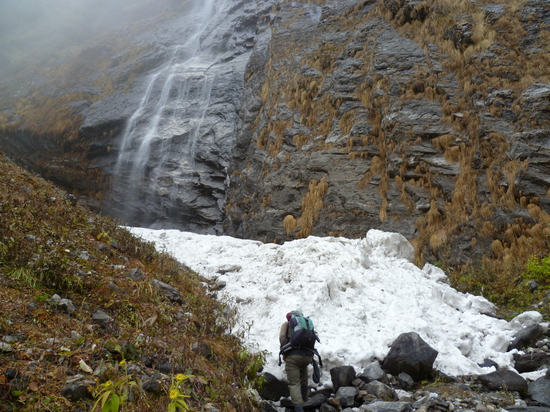
The temperature at 3PM is about two degrees indoors. To combat this, many Nepalese mountain lodges employ a unique heating device that involves a small gas stove or metal bucket being fired up and unceremoniously shoved under your dining table. When this happens for the first time, the metal bucket filled with steaming rocks of coal is so hot and such a surprise to those at the table that the proprietor takes it away again. With her bare hands.
Aside from that, we sit in and play cards, waiting for the cloud to clear and the mountains to show themselves. It’s agonising to have come so far and have nothing to look at. The metal bucket comes back at a slightly reduced temperature and we try not to think about the possibility of a cloudy morning tomorrow, buoyed by the surprisingly tolerable Khukri rum and the borderline-intolerable Bagpiper whisky. Thankfully, it’s enough to make us forget the temperature when we retire for the evening. The night is parky, certainly, but there’s every signal that our prayers at the Buddhist shrine might well be answered by morning.
When I lazily shuffle to the toilet at about 5:30 the next morning, dusk still grips the camp. When I shuffle back, though, others have arisen and are assembling numerous photographic paraphernalia. Within half an hour, there are mountains. Everywhere. It’s no exaggeration to say that in every direction you care to turn, you’ll see a 6,000+ metre peak imposing on the skyline and waiting for the sun to splash its snowy faces. In minutes the whole camp is alive and hot-footing it over to the edge of the glacier that spreads out just below ABC. There’s still the odd remnant of cloud, but it’s the friendly, wispy sort rather than the all-encompassing wet fog of yesterday. When the sun breaches this panorama, it becomes a giant’s play-set. Gargantuan lumps of fissured rock are scattered clumsily about, the result of ancient landslides as well as newer ones, but we’re free and happy to quietly wander amongst it all. Curiously, attempts to capture the scale work best if your photo happens to include the inexplicable grey volleyball court that someone built years ago, the pitifully human juxtaposed with beastly nature.
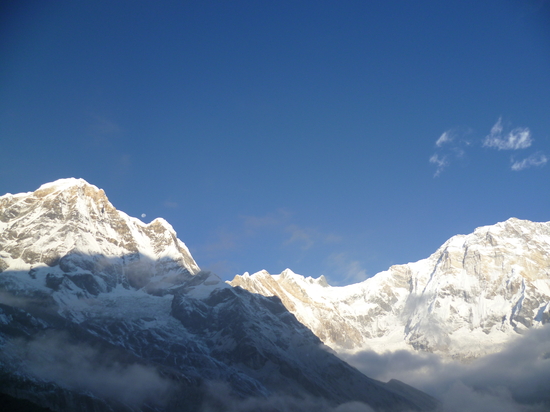
But then, all too soon, we have to leave. A proper climbing group assemble in the paved area outside our lodge. Amongst their substantial kit is a snowboard, propped against one of the rucksacks like a child’s toy next to his dad’s briefcase. Before we leave, we see them slowly snake their way up the shallow rise to Annapurna. Herzog’s peak has claimed many lives, but it’s a show of not only his mettle, but the mettle of all serious mountaineers, that they’ve thought to take a fucking snowboard with them.
We’ve got a lot of descending to do, spending the next two days tramping down to Jhinu, where we’ll be welcomed with a comparatively palatial lodge and a natural hot spring to boot. It’s about as P. Diddy as we’re going to get here, anyway. As we start back along the same brown, barren path we came from yesterday, we see one more example of how quickly things can change. Behind us, on Annapurna itself, we see a huge avalanche. It’s thousands of metres away from us and looks to be glacially slow, but up close it would doubtless throw anything gleefully over a cliff. It’s impossible to say when it will stop.
Two days later, we’re in Jhinu. The hot springs are reward enough for the quick but gruelling descent, situated in a vast series of rock pools with jungle on one side and white-water rapids on the other. Once we’re back at the lodge and dried off, an impromptu disco kicks off. Somewhere, unfathomably, someone has unearthed a ghetto blaster that could easily have been thrown out of the Matsui returns department in 1992. We connect an iPhone and soon, having not heard any Western music in almost two weeks, are rattling through a bracing canon of late-80s/early-90s dance hits. The porters join us in a dance-off, and know all the words to every Michael Jackson song we put on, as well as Haddaway’s ‘What Is Love?’. By this point, we’re drunk, we’re dancing on treacherous cobbles, it’s raining and it’s dark. I look at my watch. It’s 6:45 in the evening.
Before we know it, we’re back in Kathmandu. We have to brave a night-time reversal of our terrifying bus journey here (which, curiously, is a little more soothing in the dark), and we’re able to while away a day in the capital before we head home. And we see a great many things in that day (a seven-year-old living Goddess whose position is dependent on being able to spend a night in a temple with the severed heads of 108 buffalo is chief among them, along with a statue that, if you tell a lie in front of it, makes you vomit blood until you die, after 30 seconds of agonising pain). But nothing is quite so staggering as the mountains, the avalanches and the move from calm to drama in little more than a footstep. I’ve not drunk more than one or two beers in any one day while I’ve been here, and most days I drank nothing (our early-evening rave excluded). However, I’ve never been more ill, exhausted and fully happy than when journeying to ABC.
Herzog’s triumph at Annapurna didn’t make the mountain seem remotely conquerable; it just made the world aware of its danger. Our route (a different one to his) didn’t even lay a crampon-clad foot near the danger he faced. But what we saw plenty of was the potential for everything to go wrong. Merrily skipping through the clouds is how it looks, but trudging through the muddy snow with a wet hat on is how it really is. That doesn’t make the experience any less altering or powerful, though; just more rewarding.
Perhaps we’re better off viewing the danger from a safe distance. While there are nutcases galloping up there with snowboards and stout legs, the danger is always going to be there – you just might not see it coming.

